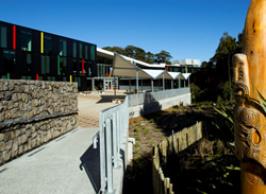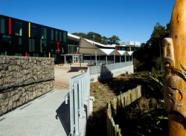Impact Projects
Impact Projects process: Download the pamphlet (PDF, 125kb)
Albany Senior High School follows a unique programme in which the whole school goes 'off curriculum' every Wednesday, with every student spending the whole day working on an Impact Project which, regardless of the subject matter, follows a process of development with close links to Technology.

Albany Senior High School.
What are impact projects?
The Impact Projects were devised to encourage students to think more independently and to pursue their interests, and also provide an opportunity to investigate areas not catered for by the school curriculum. Although the projects aren't all careers-focussed there is an underlying message in that they allow students to discover what sorts of areas the students might (or might not) be interested in as a career or life-long pursuit. Students can also take the skills and knowledge gained from an Impact Project into the workplace or tertiary education.
"Essentially, the Impact Project is about students investigating their passions," says HOD Product Design Tim Cook, "and it's driven by the students."
"Essentially, the Impact Project is about students investigating their passions" says HOD Product Design Tim Cook "and it's driven by the students". He explains that the projects fit with the Key Competencies in The New Zealand Curriculum (2007): Thinking; Using Language, Symbols, and Texts; Managing Self; Relating to Others; and Participating and Contributing. The students are expected to plan their project so that it benefits the community in some way. In 2010, for example, a group of students worked with the North Shore City Council to improve a local park by redesigning a skateboarding area. One aim behind the Impact Projects, explains Tim, is to get students used to working with and seeing themselves as part of the wider community.
Links with technology
The Impact Projects are also linked with the Technology learning area. The technological process underpins the Impact Projects because all the students follow this in their work: developing a brief, planning for practice, consulting with stakeholders, evaluating their outcome, etc.
Because the projects are based on a similar design process to Technology, Tim and TIC Food/Fabric Sharon Catchpole both took roles as cluster leaders.
The projects are based on teamwork to reflect a workplace where people have to negotiate with team members and others to successfully complete a project. A project leader assigns each member a particular role within the group. There are usually four students in a group but there is scope for smaller or larger groups if need be. One semester (two terms) is allocated for the projects to be started and completed. In the second semester students can change groups and create a new project or, if there is new learning that can be added, choose to continue with their initial project.
The students can create a project around anything they are interested in, and can approach it in whichever way best suits them. Some groups will organise their own project while others might choose to work through an organised system such as a CREST project. The programme is flexible enough to allow for students who want to go down an individual pathway or focus on a particular academic area.
Getting started
To inform students about the possibilities and help them with their decision-making, cluster group teachers set up 'bus stops' at the beginning of the semester. Students visit each 'stop' and listen to teachers talking about their specialist subjects and how they fit into Impact Projects. The presentations vary according to the teacher or the semester so Tim, for example, might talk about Technology department projects in general, a specific technological development and its impact on society or focus on a particular area his team is keen to teach.
Students are given a timeline for deciding on their project and the clear expectation is that they will bring their proposal to the teachers and will not be 'chased up' for it. Time is allowed for everyone to think about what they would like to do before they form groups to plan a project. This stage is something Tim describes as "a state of flux which, during the proposal process, will become a well-organised programme", with appropriate learning targets and other project outcomes agreed between the Impact Project mentor, cluster leader, and the group. These are agreed in discussions following the presentation of a formal proposal of their plan. Impact Project mentors and cluster leaders will look at aspects such as:
- Is the project feasible?
- Is it authentic?
- Does it have strong community links?
- What specialist subject(s) does it link with?
- The deep learning involved in the project; and
- Can they achieve their aims in the time available?
A lot of groups will use one of the Technology workrooms for all or part of their project. A group might create a product in the Food Technology room, for example, and then video it and finish working on their project in the Media Studies area. Tim says that the Product Design department tries to support students' individual and group interests and will do their best to fund specialist equipment needed for particular projects, recent examples include equipment for the robotics team and the jewellery-making group. More often, the equipment needed is already contained within the department.
After submitting their proposal and starting work, students often realise after three or four weeks that their final outcome is going to be significantly different to their original proposal. Teachers are ready to reassure them that a change in direction is perfectly acceptable in an Impact Project (as with a Technology project) and that, in consultation with their mentor, they just need to ensure that any change is reflected in the planning. Students keep all their documentation in e-portfolios which their mentor looks at regularly. They also make a small presentation on their progress to their cluster group every week, as another skill underpinning the programme is the ability to present ideas.
Partnering with experts
Working with outside experts is important for the Impact Projects and the support they provide means that students aren't limited in the scope of their work. The school is in the process of creating a database with details of people and organisations willing to assist students with their projects in some way.
Every teacher acts as a facilitator/mentor for individual groups which, Tim says, can put pressure on them to upskill if they need to help students with particular techniques, etc. Sometimes they will try to find somebody in the community with the requisite skills and expertise, which might involve facilitating meetings or a lecture at school or sending students out to meet an expert. Several groups with an interest in cars, for example, have worked with mechanics at local garages where they have received advice and learnt skills which have helped with their project. Students can also make their own links within the community to facilitate their projects.
Project presentations
On completion of their project the group makes a formal presentation to their cluster group and answers any questions put to them by their mentor or the group. The students are assessed on the quality of their presentation, to underline that this is the sort of thing they may have to do in the workplace or in higher education, so watching others is helpful in showing them the elements and styles that make a successful presentation.

